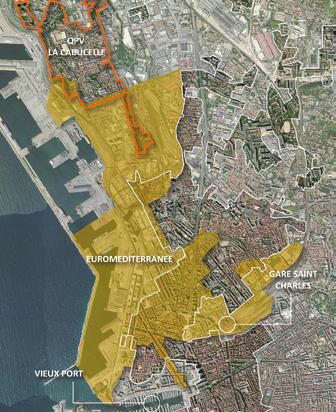
2 minute read
Marseille (FR
SCALES — XL/S – territory / architecture + context LOCATION — Marseille, La Cabucelle district POPULATION — City 862,000 inhab. District 14 231 inhab. STRATEGIC SITE — 150 ha PROJECT SITE — 90 ha SITE PROPOSED BY — Marseille Rénovation Urbaine

Advertisement

OWNER OF THE SITE — City of Marseille, department of Bouches du Rhône, state, social landlords, Region PACA, multiplicity of private actors POST-COMPETITION PHASE — Urban and architectural feasibility study, mastery of urban and architectural work to initiate with operational partners
Aix Marseille Provence Metropolis —
1. WHAT ARE THE GOALS OF THE SITE MUTATION? In the district of La Cabucelle, the goals of the city are mixed: housing in various forms and large industrial tenements, mixed with small businesses, that the Metropolis wants to maintain. The Urban Renewal Project, the main lines of which are under construction, wants to support the dynamics underway in the district: encourage existing initiatives, both associative, entrepreneurial and public, in order to integrate them into a global project. The community wants to be a facilitator more than an initiator. It is a question of specifying a goal for the Cabucelle district, and of providing this district with the tools allowing its endogenous development. The arrival of the metro at the end of 2019, and of the tram by 2025, but also the existence of public investments (TC, Carburateur), but also as private and associative (association Cap au Nord Entreprendre…), on the district, are as many assets for a smooth mutation, going in the direction of a dynamics that is favourable to the actors and the current and future inhabitants of the district.
2. HOW CAN THE SITE BE INTEGRATED IN THE ISSUES OF PRODUCTIVE CITIES? HOW DO YOU CONSIDER THE PRODUCTIVITY ISSUE?
This site bears in itself the marks of a reduction in industrial production activity for a long time: wasteland in mutation, evolution of activity towards the tertiary sector, even sometimes substitution of the activity by housing. One of the challenges is to maintain employment-generating activities and integrate them into a neighbourhood where residents live. It is therefore a question of tending towards a productive city where it is good to come to work, to live, but also to exchange, a city which could adapt to the requirements of an adaptation or readjustment to local challenges and provide its users with the sufficient amenities and an attractive environment.
3. HAVE YOU ALREADY DEFINED A SPECIFIC PROCESS FOR THE URBAN AND/OR ARCHITECTURAL DEVELOPMENT OF THE SITE AFTER EUROPAN COMPETITION?
We are based on the concept of metabolisms developed during the various seminars the city as a metabolism able to reuse wealth, assets, materials, in order to create something else.










